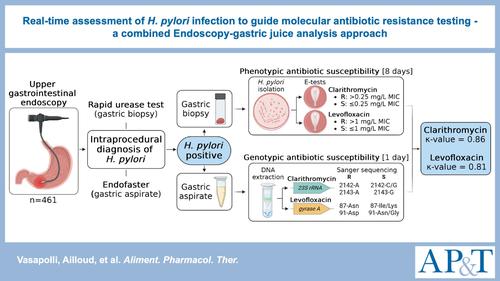当前位置:
X-MOL 学术
›
Aliment. Pharm. Ther.
›
论文详情
Our official English website, www.x-mol.net, welcomes your
feedback! (Note: you will need to create a separate account there.)
Real‐Time Assessment of H. pylori Infection to Guide Molecular Antibiotic Resistance Testing: A Combined Endoscopy‐Gastric Juice Analysis Approach
Alimentary Pharmacology & Therapeutics ( IF 6.6 ) Pub Date : 2024-11-12 , DOI: 10.1111/apt.18378 Riccardo Vasapolli, Florent Ailloud, Beate Spießberger, Peter Malfertheiner, Sebastian Suerbaum, Christian Schulz
Alimentary Pharmacology & Therapeutics ( IF 6.6 ) Pub Date : 2024-11-12 , DOI: 10.1111/apt.18378 Riccardo Vasapolli, Florent Ailloud, Beate Spießberger, Peter Malfertheiner, Sebastian Suerbaum, Christian Schulz

|
BackgroundHelicobacter pylori antibiotic resistance is the most relevant cause of treatment failure. Antibiotic susceptibility testing (AST) allows for selecting the appropriate eradication regimen.AimsTo assess the diagnostic accuracy of gastric aspirate‐based genotypic AST (G‐AST) for detecting clarithromycin and levofloxacin resistance compared with conventional phenotypic AST (P‐AST).MethodsWe recruited 461 consecutive patients scheduled for endoscopy. H. pylori was detected intraprocedurally using Endofaster, a novel method combining endoscopy with gastric juice analysis. For H. pylori ‐positive patients, we collected gastric aspirates and biopsies. G‐AST was performed using DNA extracted from aspirates, with Sanger sequencing to detect polymorphisms in the 23S rRNA and gyrA genes associated, respectively, with resistance to macrolides and fluoroquinolones. P‐AST was performed on H. pylori isolated from biopsies using ETEST.ResultsOne hundred and seventy‐eight (40.4%) patients tested positive for H. pylori during endoscopy. Paired gastric biopsies and aspirates were available from 152 H. pylori ‐positive patients. By P‐AST, resistance rates were 15.1% (23/152) for clarithromycin and 18.4% (28/152) for levofloxacin. G‐AST showed a high level of agreement with P‐AST for clarithromycin (kappa 0.86) and levofloxacin (kappa 0.81) resistance and diagnostic accuracy of 97% and 95%, respectively.ConclusionsThe novel method combining endoscopy with immediate intraprocedural gastric juice analysis for the detection of H. pylori , followed by AST in case of a positive finding, is valid and practical for tailoring eradication regimens for H. pylori infection. Genotypic AST from gastric aspirates is highly accurate for detecting clarithromycin and levofloxacin resistances.
中文翻译:

实时评估幽门螺杆菌感染以指导分子抗生素耐药性检测:一种内窥镜检查-胃液分析相结合的方法
背景幽门螺杆菌抗生素耐药性是治疗失败的最相关原因。抗生素敏感性试验 (AST) 允许选择合适的根除方案。目的 评价基于胃抽吸物的基因型 AST (G-AST) 检测克拉霉素和左氧氟沙星耐药性与常规表型 AST (P-AST) 相比的准确性。方法我们连续招募了 461 例计划进行内窥镜检查的患者。使用 Endofaster 在程序中检测幽门螺杆菌,这是一种将内窥镜检查与胃液分析相结合的新方法。对于幽门螺杆菌阳性患者,我们收集了胃抽吸物和活检。使用从抽吸物中提取的 DNA 进行 G-AST,并使用 Sanger 测序检测 23S rRNA 和 gyrA 基因中的多态性,分别与大环内酯类和氟喹诺酮类药物的耐药性相关。使用 ETEST 对从活检中分离的幽门螺杆菌进行 P-AST。结果178 例 (40.4%) 患者在内窥镜检查期间检测出幽门螺杆菌阳性。152 例幽门螺杆菌阳性患者可获得配对胃活检和抽吸物。根据 P-AST,克拉霉素的耐药率为 15.1% (23/152),左氧氟沙星的耐药率为 18.4% (28/152)。G-AST 对克拉霉素 (kappa 0.86) 和左氧氟沙星 (kappa 0.81) 耐药性与 P-AST 高度一致,诊断准确性分别为 97% 和 95%。结论内镜检查与即刻术中胃液分析相结合检测幽门螺杆菌的新方法,如果发现阳性,则进行 AST,对于定制幽门螺杆菌感染的根除方案是有效和实用的。来自胃抽吸物的基因型 AST 对于检测克拉霉素和左氧氟沙星耐药性非常准确。
更新日期:2024-11-12
中文翻译:

实时评估幽门螺杆菌感染以指导分子抗生素耐药性检测:一种内窥镜检查-胃液分析相结合的方法
背景幽门螺杆菌抗生素耐药性是治疗失败的最相关原因。抗生素敏感性试验 (AST) 允许选择合适的根除方案。目的 评价基于胃抽吸物的基因型 AST (G-AST) 检测克拉霉素和左氧氟沙星耐药性与常规表型 AST (P-AST) 相比的准确性。方法我们连续招募了 461 例计划进行内窥镜检查的患者。使用 Endofaster 在程序中检测幽门螺杆菌,这是一种将内窥镜检查与胃液分析相结合的新方法。对于幽门螺杆菌阳性患者,我们收集了胃抽吸物和活检。使用从抽吸物中提取的 DNA 进行 G-AST,并使用 Sanger 测序检测 23S rRNA 和 gyrA 基因中的多态性,分别与大环内酯类和氟喹诺酮类药物的耐药性相关。使用 ETEST 对从活检中分离的幽门螺杆菌进行 P-AST。结果178 例 (40.4%) 患者在内窥镜检查期间检测出幽门螺杆菌阳性。152 例幽门螺杆菌阳性患者可获得配对胃活检和抽吸物。根据 P-AST,克拉霉素的耐药率为 15.1% (23/152),左氧氟沙星的耐药率为 18.4% (28/152)。G-AST 对克拉霉素 (kappa 0.86) 和左氧氟沙星 (kappa 0.81) 耐药性与 P-AST 高度一致,诊断准确性分别为 97% 和 95%。结论内镜检查与即刻术中胃液分析相结合检测幽门螺杆菌的新方法,如果发现阳性,则进行 AST,对于定制幽门螺杆菌感染的根除方案是有效和实用的。来自胃抽吸物的基因型 AST 对于检测克拉霉素和左氧氟沙星耐药性非常准确。


















































 京公网安备 11010802027423号
京公网安备 11010802027423号